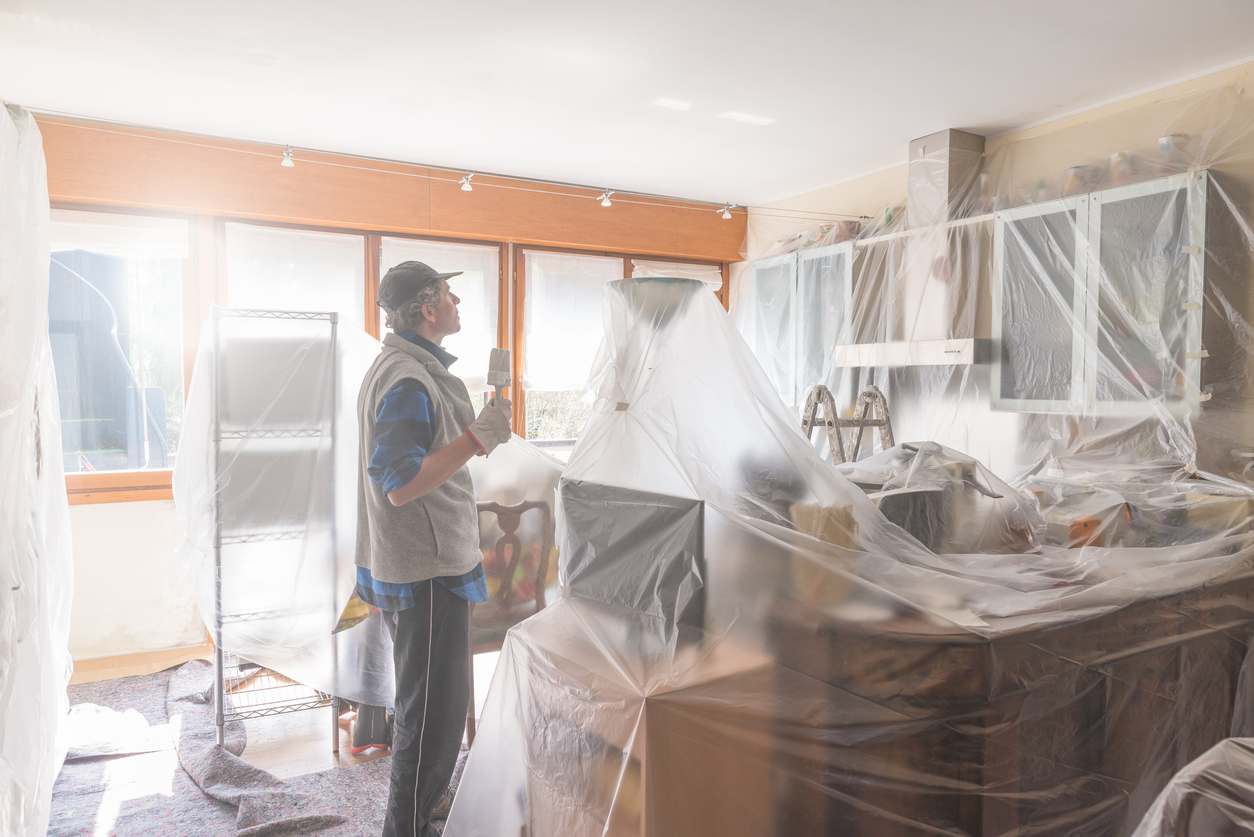If you’ve ever hired Livermore area house painters, you probably noticed them covering your couches and tables before starting their work. This step is crucial because when you paint a room, it’s inevitable that some paint will drip or splatter. This is where covers take an important role when painting a house.
Why Do You Need to Cover Furniture When Painting a Space?
Covering furniture is a crucial part of preparing a room for painting. Imagine accidentally spilling paint on your favorite couch or scratching a beautiful wooden table. Not fun, right? Covering your furniture properly can prevent these accidents from happening. Here’s why protecting your furniture before painting is essential:
- Prevents damage to surfaces: Paint can damage surfaces if it sits too long. Removing paint can be tedious, and you risk damaging your furniture. Covering them prevents this hassle.
- Saves time and money: Protecting your furniture can save you from costly mistakes that might require repairs or even a total do-over. Although covering furniture might seem trivial, it saves you time and money in the long run.
- Ensures a fast and efficient paint job: Initially, covering furniture might seem like a waste of time. However, it prevents additional, unexpected time and expenses spent dealing with damage from spilled paint. With furniture protected, you can complete your paint job faster and more efficiently.
Preparation for Covering
Before you start painting, take a little time to prepare the room. First, move as much furniture out of the room as possible. The fewer items you have to work around, the easier it will be to paint.
For the furniture you can’t move, that’s when a cover can be very helpful. Also, don’t forget to remove any electrical plates and cover the outlets. This not only keeps them paint-free but also helps ensure your safety while painting.
Materials for Covering Furniture
When it comes to protecting your furniture during a paint job, you have a few good options to choose from. Let’s talk about three common materials: canvas drop cloths, plastic sheeting, and paper coverings.
Canvas Drop Cloths
Canvas drop cloths are a fantastic choice because they are durable and reusable. While expensive, these can be used multiple times, which makes them cost-effective in the long run. They’re heavy enough to stay in place and are great at absorbing paint spills. However, they can be a bit pricey upfront and might be overkill for small projects.
Plastic Sheeting
Plastic sheeting is another popular option. It’s waterproof and disposable, making it easy to handle and perfect for quick clean-up. It’s also generally less expensive than canvas. On the downside, it can be slippery to walk on and might not stay in place as well as canvas, which means you might need to use some tape to secure it.
Paper Coverings
Paper coverings, like rosin paper or contractor’s paper, are economical and work well for large areas. They’re easy to roll out and cut to size, making them user-friendly. However, they’re not as durable as canvas or plastic and can tear easily, especially if they get wet.
Steps to Cover Furniture
Covering your furniture properly is easy if you follow these simple steps. Here’s a step-by-step guide to help you out:
- Select appropriate covering material: Choose the material that best suits your needs—canvas for durability, plastic for waterproofing, or paper for an economical option.
- Measure and cut the material to fit: Measure your furniture to ensure you have enough covering material. Cut it to size, leaving some extra for tucking in and securing.
- Secure covering with tape or clips: Use painter’s tape or clips to hold the covering in place. Make sure it’s tight and won’t shift during the painting process.
- Ensure all surfaces are adequately covered: Double-check that every part of the furniture is covered, including the legs and any exposed edges. This will ensure that no paint accidentally lands on your items.
Tips for Using Covers for Interior Painting
When painting a room, there are a few extra things to keep in mind to ensure everything goes smoothly.
- Don’t forget to protect floors! Lay down drop cloths or rosin paper to catch any drips or spills. This will keep your flooring safe from paint damage.
- Ensure proper ventilation. This is crucial to avoid inhaling paint fumes. Open windows and doors, and use fans if necessary to keep the air circulating. This not only helps with the fumes but also speeds up the drying process.
- Painter’s tape is your best friend for securing coverings and creating clean edges. Use it to hold down your floor coverings and to mask off areas where you don’t want paint, like crown molding, trim and baseboards. This will help you achieve professional-looking results without the mess.
DIY vs. Professional Help
When it comes to painting, you might wonder whether to do it yourself or hire Dublin, CA professionals. Let’s explore both options.
Benefits of Hiring Professionals
Hiring professionals can be a smart choice if you want high-quality results without the hassle. Pros have the experience and tools to do the job efficiently and correctly. They can handle tricky areas and complex techniques, ensuring a flawless finish. Plus, they take care of all the prep work, saving you time and effort.
Tips for DIY Enthusiasts
If you decide to tackle the painting yourself, here are some tips to help you succeed:
- Plan ahead: Make sure you have all the necessary supplies before you start.
- Take your time: Rushing can lead to mistakes, so work at a steady pace.
- Practice: If you’re new to painting, practice on a small area first.
- Use quality materials: Invest in good paint, brushes, and rollers for better results.
- Follow safety precautions: Wear protective gear and ensure proper ventilation.
Common Challenges and Solutions
Painting a room can present a few common challenges, especially when dealing with large or oddly-shaped furniture and tight spaces. Here’s how to handle these situations:
Handling Large or Oddly-Shaped Furniture
When you have big or uniquely shaped furniture, it can be tricky to cover and move it. If possible, disassemble the furniture to make it easier to handle. For pieces that can’t be taken apart, use multiple coverings to ensure every part is protected. Don’t hesitate to use extra tape or clips to secure the covering material firmly.
Dealing with Tight Spaces
Tight spaces can make painting a challenge. To make it easier, remove as much clutter as possible and use smaller, more maneuverable tools like mini rollers and brushes. This will help you get into those hard-to-reach spots without making a mess. Take your time and be patient to ensure you cover every area properly.
Conclusion
Painting a room can be a rewarding project, especially when you take the time to protect your furniture and prepare properly. Whether you decide to do it yourself or hire professionals, these tips can help you achieve great results and keep your belongings safe.
If you’re looking for a hassle-free experience with top-notch results, consider reaching out to Custom Painting, Inc. Our team has more than 40 years of experience in the paint service industry, and we have the necessary tools to handle any painting job. Give us a call today at 925-294-8062 or fill out our contact form and let the professionals take care of your next painting project!




